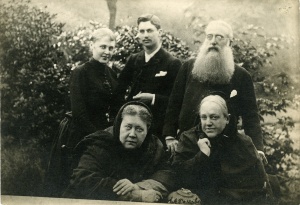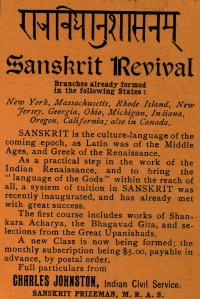Charles Johnston
Charles Johnston was a Sanskrit scholar and translator of several Hindu classics, and was married to H. P. Blavatsky's niece. He was a founder of the Dublin Lodge of the Theosophical Society of which William Butler Yeats and A.E. or Æ, as George William Russell was known, were also members. The Johnstons became members of the Theosophical Society in America headed by Ernest Temple Hargrove in New York.
Early life
Charles Johnston was born in Ireland, at Ballykilbeg, County Down, on February 17, 1867. His father was a prominent Orangeman, a Member of Parliament for Belfast and leader of the temperance movement. His mother was the daughter of Sir John Hay, a Scottish baronet. Johnston's education was at Derby, England, and later at Dublin University, where he became acquainted with the Irish poets William Butler Yeats and George William Russell, who became known as A.E. or Æ.[1]
As a 17-year-old, in November, 1884, Johnston read A. P. Sinnett's The Occult World, and the following year joined the Theosophical Society. When Madame Blavatsky was attacked by the Society for Psychical Research in the Coulomb affair, Johnston "made a vigorous protest in H.P.B.'s defence"[2] He read Esoteric Buddhism, Isis Unveiled, Light on the Path, and Five Years of Theosophy, and in 1887 met Madame Blavatsky in person. During his years at university, he had prepared for the Bengal Civil Service exam, which he passed brilliantly in 1888. In August of that year, he married Vera Vladimirovna de Zhelihovsky, daughter of Madame Vera Petrovna de Zhelihovsky and H. P. Blavatsky's niece. They had met while she was staying with her aunt in London. The ceremony took place at H.P.B.'s home, 17, Lansdowne Road, London. Col. Olcott, visiting London at the time, represented Vera's mother and the rest of the family at the civil marriage at the registrar's office.[3]
Shortly after the wedding, the Johnstons left for India, arriving in November. He contracted malaria, and became so ill that he was sent home after only two years in the Civil Service position for which he had trained. In order to make a living he turned to writing for periodicals:
He succeeded in connecting himself with some English journals, to which he sent letters on foreign news, and he contributed, to the more serious reviews, articles on ethnological, political and economic questions. Thus employed, for the next six years he andhis wife tavelled extensively in Europe, visiting her relatives - Madame Blavatsky's nearest kin - in Russia, and staying in different places in England, Holland, Belgium, Germany, Austria, and France. They lived for some time in Salzburg, where Dr. Franz Hartmann then resided, and where Mr. Johnston finally threw off his jungle malaria.[4]
Life in New York
The Johnstons emigrated to the United States, becoming naturalized citizens in 1908 . In 1900, they were living in Queens; in 1910 had moved to Manhattan; and in 1920 were in Brooklyn.[5] At the request of the American Theosophical Society leader William Quan Judge,
Mr. Johnston undertook a series of translations from the Sanskrit, which were made a regular feature of the Theosophical Society's literary activity, being published by Mr. Judge as the "Oriental Department papers". It was from the work done in this connection that his first separate volume on the Indians scriptures, From the Upanishads, was culled.[6]
The Theosophical Society was in turmoil in the years just after 1895, when most American lodges chose to follow Mr. Judge into formation of an American society that was dissociated from the international headquarters based in Adyar, India. Judge's death in 1896, and the changes instituted by his successor Katherine Tingley created difficulties that led to the formation of the Theosophical Society that was led by Ernest Temple Hargrove. The Johnstons became mainstays of that group. Charles Johnston served for more than 25 years as Chairman of the Executive Committee.
Teaching
Charles Johnston lectured for the Theosophical Society, travelling across the United States and Europe to visit branches. He also lectured and taught at educational institutions.
He lectured at Cooper Union, and for the New York Board of Education. In 1908, he was Special Lecturer in Political Science at the University of Wisconsin... and he also delivered a number of addresses at Columbia university in New York. At one time he taught at the Russian Seminary.[7]
In his first months in New York, he advertised a Sanskrit course on the inside back cover of Theosophy magazine in September 1897. It mentions classes formed in New York, Massachusetts, Rhode Island, New Jersey, Georgia, Ohio, Michigan, Indiana, Oregon, California, and Canada.[8]
Later years
Mr. Johnston was an active member of the Linnaean Society, a group of amateur and professional naturalists in the New York City area who studied natural history and especially ornithology.
According to Henry Bedinger Mitchell, "In 1918-19, he served as Captain in the Military Intelligence Division at Washington."[9]
The 1930 United States Census listed Johnston as a writer and editor, with Encyclopedia Britannica as an employer.
He died on October 16, 1931 of heart disease.
Writings
Mr. Johnston wrote a great number and variety of articles and books, ranging from scholarly writings on scriptures to popular volumes of humor, travel, and history. The flair and grace of an Irish poet are apparent even in the serious works. See, for example, the introduction to The Song of Life, and the dedication, addressed to his Irish friend George William Russell, in From the Upanishads. Ireland: Historic and Picturesque is a charming travelogue, and Kela Bai: An Anglo-Indian Idyll is a tale from India.
During 46 years of service to the Theosophical movement, Johnston was a very prominent and highly esteemed author. The first article that Johnston wrote for the Theosophical Society was printed in the December, 1886 issue of The Theosophist, when he was only 19 years old. After his death, The Theosophical Quarterly summarized his contributions:
A succession of articles followed, totalling 16 in all. He contributed 27 articles to Lucifer, beginning with the first volume, December, 1887, and continuing until the Society ceased to concern itself with that publication, which passed into alien hands. Five of these comprised his first translations from the Upanishads, while in addition there were eight half-pages of translated aphorisms. He contributed 15 articles to The Irish Theosophist; 20 to the Path; 8 to Theosophy in the less than two years of its brief existence; 53 translations in the series of Oriental Department Papers, all from the Sanskrit; 53 that have been identified in the The Theosophical Forum (where in the later volumes all articles were unsigned), of which 26 were translations; and 242 articles to the Theosophical Quarterly, from its first to the current volume, not including reviews, answers to questions, or his addresses reported during the sessions of Convention. This is an average of 8 1/2 articles a year for the QUARTERLY, or more than two for each issue. The total number of articles is, therefore, about 434, of which 170 were translations, or an average of almost 10 articles a year for the 44 years he was writing for the Movement.[10]
This was all voluntary effort; he was not compensated for this work.
The Union Index of Theosophical Periodicals has over 200 articles listed under the name Charles Johnston. Many other articles were published with the initials CJ, but many of those were written by C. Jinarājadāsa of Adyar.
numerous reprints
He also published numerous articles for non-Theosophical journals and newspapers, including several articles in The Open Court:
- "The Vedanta Philosophy" in February, 1906. Available at OpenSIUC.
- "The Kingdom of Heaven and the Upanishads" in December, 1905. Available at OpenSIUC.
- "The Childhood and Youth of St. Paul" in April, 1911. Available at OpenSIUC.
Mr. Johnston published these Theosophical books:
- Useful Sanskrit Nouns and Verb in English Letters. London: Luzac, 1892. Text available online at Internet Archive. Advertised on page 59 of Luzac's Oriental List and Book Review, Volume 4 by Luzac & Co., booksellers. Advertisement is available online at Google Books.
- The Awakening to the Self. Translation of Sankarâchârya. New York: Johnston, 1897.
- From the Upanishads. Portland, ME: Thomas Mosher, 1899. Available online at Internet Archive and Hathitrust.
- The Memory of Past Births. New York: Theosophical Society Publishing Co., 1899. Available to Internet Archive and Hathitrust.
- Karma: Works and Wisdom. New York : Metaphysical Pub. Co., 1900. Available at hathtrust.
- The Song of Life. Flushing, NY: Charles Johnston, 1901. A translation of the "dialogue of Janaka and the sage", preceded by "a modern paraphrase of the Teachings". Available at Internet Archives.
- The Bhagavad-gîta: "The Songs of the Master". Flushing, N.Y.: C. Johnston, 1908. Available online at Internet Archive.
- Parables of the Kingdom. Flushing, NY: Charles Johnston, 1909.
- The system of the Vedânta according to Bâdarâyaṇa's Brahma-sûtras and Cankara's commentary thereon set forth as a compendium of the dogmatics of brahmanism from the standpoint of Çankara. Chicago, The Open Court Publishing Company, 1912. Available at Internet Archive and Hathitrust.
- Yoga Sutras of Patanjali. 1912. Available online at Wikisource and Hathitrust.
- Eastern and Western Psychology: a Theosophical Need. New York: Theosophical Society, 1917.
- The Great Upanishads, Isha, Kena, Katha, Prashna, Upanishads Volume 1. New York: Quarterly Book Department, 1927.
- The Crest-Jewel of Wisdom by Śankarâchârya. San Diego: Theosophical University Press, 1946. Translated by Charles Johnston. Available at Theosophical University Press Online.
Popular books:
- Kela Bai: An Anglo-Indian Idyll. New York: Doubleday & McClure, 1900. Novel. Available at Internet Archive.
- Ireland: Historic and Picturesque. Philadelphia: Henry T. Coates & Co., 1902. Illustrated travelogue. Available at Internet Archive and a second Internet Archive version.
- Ireland's Story. Boston: Houghton, Mifflin, 1905, 1923. Written with Carita Spencer. Illustrated history of Ireland. Available at Internet Archive.
- Why the World Laughs. New York: Harper & Bros, 1912. A book of humorous stories from many countries. Available at Internet Archive and Hathitrust.
Notes
- ↑ H. B. M.[Henry Bedinger Mitchell] "Charles Johnston", The Theosophical Quarterly 29.3 (January, 1932), 214.
- ↑ Charles Johnston, The Theosophical Quarterly 29.1 (July, 1931).
- ↑ Henry Steel Olcott, Old Diary Leaves Fourth Series (Adyar, Madras: The Theosophical Publishing House, 1974), 71.
- ↑ H. B. M.[Henry Bedinger Mitchell] "Charles Johnston", The Theosophical Quarterly 29.3 (January, 1932), 207.
- ↑ U. S. Census records, 1900, 1910, 1920.
- ↑ H. B. M.[Henry Bedinger Mitchell], 211.
- ↑ H. B. M.[Henry Bedinger Mitchell], 211.
- ↑ "Sanskrit Revival" advertisement in Theosophy 12.6 (September 1897).
- ↑ H. B. M.[Henry Bedinger Mitchell], 211.
- ↑ Q.[author unknown], "Mr. Johnston and the Upanishads", The Theosophical Quarterly29.3 (January, 1932), 214-215.

